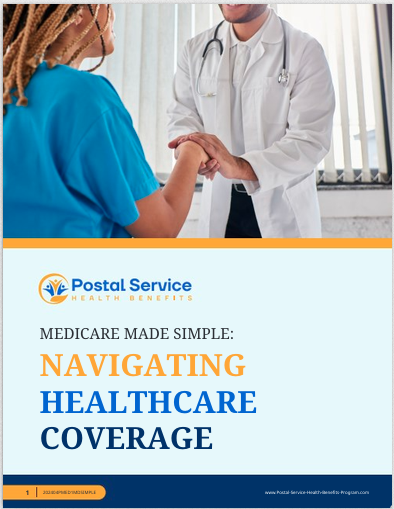Key Takeaways:
- You can avoid penalties by enrolling in Medicare Part B during a special window before Postal Service Health Benefits (PSHB) take over in January 2025.
- USPS retirees who missed previous Medicare enrollment still have opportunities to join Medicare Part B without extra costs if they act during specific enrollment periods.
Transitioning to Medicare Part B Before PSHB: Why Timing is Critical
With the Postal Service Health Benefits (PSHB) program launching on January 1, 2025, USPS employees and retirees need to be prepared for the changes ahead. This shift, part of the Postal Service Reform Act of 2022, will move postal workers from the Federal Employees Health Benefits (FEHB) program to the PSHB system. If you’re near or past Medicare eligibility, it’s essential to get familiar with Medicare Part B, especially if you’re not already enrolled.
The Importance of Enrolling in Medicare Part B
Medicare Part B covers doctor visits, outpatient services, and other important healthcare needs not covered under Medicare Part A. When the PSHB program officially kicks in, postal retirees who qualify for Medicare will need to decide whether or not to enroll in Part B. For those retiring after January 1, 2025, enrollment in Medicare Part B is mandatory to maintain their PSHB coverage when they reach Medicare eligibility (usually age 65).
If you’re already on Medicare or close to that point, you might be wondering about the timing and how to avoid late penalties. Let’s break down the key dates, windows for enrollment, and what you need to do to ensure you’re not hit with unnecessary fees.
Key Enrollment Dates to Remember
- PSHB Open Season: November 11 – December 9, 2024
- PSHB Program Launch: January 1, 2025
While the Open Season allows you to review and adjust your PSHB and other benefits, the transition to PSHB also opens up opportunities to make sure your Medicare coverage is in line with your new health benefits plan. If you haven’t signed up for Medicare Part B yet and are already eligible, this transition period could be a good time to get your paperwork in order.
Medicare Part B Late Enrollment Penalty: What It Is and How to Avoid It
Normally, if you don’t enroll in Medicare Part B when you first become eligible (age 65 for most), you’ll be charged a late enrollment penalty. This penalty can increase your monthly Medicare Part B premium by 10% for each 12-month period you were eligible but didn’t sign up. That adds up over time!
The good news? USPS retirees who missed their Medicare Part B enrollment can still avoid these penalties through a Special Enrollment Period (SEP) that was offered from April to September 2024. If you missed this SEP, it’s worth keeping an eye out for other enrollment opportunities, as USPS has taken steps to ensure that retirees can get on board with Medicare without being hit with late fees.
If You Retired Before January 1, 2025: No Part B Requirement
For those who retired before January 1, 2025, you’re not required to enroll in Medicare Part B to keep your PSHB coverage. This applies even if you’ve reached the age of Medicare eligibility. However, enrolling in Medicare Part B can still be beneficial, as many PSHB plans offer significant cost savings when Part B is integrated into your coverage. Some of these benefits include:
- Reimbursement of Medicare Part B premiums
- Waived deductibles
- Lower out-of-pocket costs for healthcare services
If these savings are appealing to you, it might be worth considering Medicare Part B even if you’re not required to enroll.
If You Retire After January 1, 2025: You Must Enroll in Part B
For postal employees planning to retire after January 1, 2025, it’s a different story. You’ll be required to enroll in Medicare Part B once you become eligible to keep your PSHB coverage. This requirement extends to all covered family members as well. So, if you’re approaching retirement, now is the time to start planning.
How to Enroll in Medicare Part B
Enrolling in Medicare Part B is relatively straightforward. You can sign up through the Social Security Administration (SSA), either online or by visiting your local SSA office. The process involves filling out an application and providing some basic documentation, such as your birth certificate and previous health insurance details.
During the Special Enrollment Period (SEP) for USPS retirees, late enrollment penalties were waived, meaning you could have signed up for Part B without facing any financial repercussions. If you missed that window, you’ll need to make sure you sign up during your Initial Enrollment Period (IEP) or a future General Enrollment Period (GEP) to avoid the late fees.
Cost Considerations for Medicare Part B
While avoiding penalties is crucial, it’s also important to know what Medicare Part B will cost you. Medicare Part B premiums are generally based on your income, and while some USPS retirees may receive Part B premium reimbursements through their PSHB plan, it’s essential to confirm this with your specific plan during Open Season.
Here’s a quick breakdown of what your biweekly PSHB premiums might look like based on the PSHB estimates for 2025:
- Self Only: $397.35
- Self Plus One: $858.89
- Self and Family: $934.65
Keep in mind that the government covers 72% of these premiums, meaning your contribution will be the remaining 28%. The specific costs depend on your situation, but knowing this breakdown can help you understand how Part B fits into the larger picture of your healthcare costs.
Exceptions to the Medicare Part B Requirement
There are a few exceptions to the Medicare Part B requirement if you retire after 2025:
- Living outside the U.S. – If you don’t reside in the U.S., Medicare doesn’t apply, and you won’t need to enroll in Part B.
- Receiving care through the VA or Indian Health Services – If you get your healthcare from one of these agencies, you might also be exempt from enrolling in Medicare Part B.
If either of these exceptions applies to you, you should still reach out to the PSHB program to ensure you’re covered in other areas and understand how your healthcare benefits work internationally or under the VA system.
How Medicare Part B Can Save You Money Under PSHB
Integrating Medicare Part B into your PSHB coverage comes with some potential savings. Many PSHB plans offer Medicare Part B premium reimbursements, which can offset the costs of having Part B in the first place. Additionally, with Part B, you may see reduced out-of-pocket costs for things like hospital stays, doctor visits, and prescriptions.
This integration of benefits means that while you’re paying for Medicare Part B, you’re potentially saving a lot on medical expenses in the long run. For anyone who frequently visits the doctor or has ongoing healthcare needs, the savings can be significant.
Final Thoughts: Don’t Miss Out on Medicare Enrollment Before PSHB Takes Over
As the January 1, 2025 launch date for the Postal Service Health Benefits program approaches, ensuring that your Medicare Part B enrollment is up to date is key. Whether you’re already retired or planning to retire after the new year, understanding your Medicare requirements and options can save you money and prevent penalties.
Make sure to take advantage of the upcoming PSHB Open Season between November 11 and December 9, 2024. This is the perfect opportunity to review your benefits and make any necessary changes to ensure that you’re fully prepared for 2025. Don’t let deadlines slip by—plan your enrollment early and avoid the headaches of late fees and penalties.






